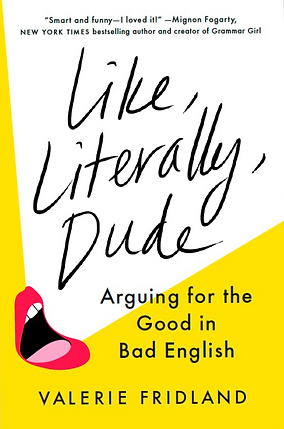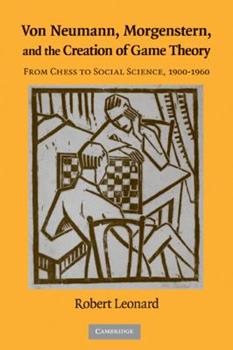Like, Literally, Dude by Valerie Fridland
 Like, Literally, Dude is one of those books that makes me wish I was still teaching, so I could assign it. Fridland, a professor of linguistics at the University of Nevada, Reno, brings together the research on just about all of the bits of usage that your misinformed, snooty relatives rant about: the use of uh and um, the use of like, vocal fry, saying workin’ rather than working, referring to any manner of dudes and, of course, the much-maligned figurative use of literally. I learned new things about each of these phenoms. What’s more, Fridland writes in an engaging and funny manner without stinting on linguistic accuracy. So before you opine about anyone’s bad English—or fret about your own—give Like, Literally Dude, a read.
Like, Literally, Dude is one of those books that makes me wish I was still teaching, so I could assign it. Fridland, a professor of linguistics at the University of Nevada, Reno, brings together the research on just about all of the bits of usage that your misinformed, snooty relatives rant about: the use of uh and um, the use of like, vocal fry, saying workin’ rather than working, referring to any manner of dudes and, of course, the much-maligned figurative use of literally. I learned new things about each of these phenoms. What’s more, Fridland writes in an engaging and funny manner without stinting on linguistic accuracy. So before you opine about anyone’s bad English—or fret about your own—give Like, Literally Dude, a read.
Voices of Our Ancestors: Language Contact in Early South Carolina. By Patricia Causey Nichols.
For a long time, I’ve hoped that some publisher would produce a series of linguistic histories of all 50 states (publishers, are you listening?). When they do, they can use Patricia Nichols’s fine sociolinguistic history of South Carolina as a model. Nichols brings together insight from has historical records and social sciences along with her own observations as field researcher in her home state. The book is organized in two-parts: the first describes the people in colonial South Carolina (Natives, Europeans, and African) and their diverse languages – more than I imagined—The second part focused especially on Gullah (drawing on Nichols’s own field research) and on the English that arose from the language contact situation in the state. Nichols pays careful attention to the rhetorical situations of speech communities and offers a number of illustrative short narrative texts to round things out.
The Thief by Fuminori Nakamura
A noirish tale about a veteran pickpocket, an anonymous crook who steals by reflex and lives a solitary life, hiding from his past. He gets pulled into more a new crime when an old partner makes him an offer he can’t refuse and he becomes enmeshed in forced beyond his control. Some interesting social criticism, but I though the ending was disappointing. I’ll read more Nakamura though!
The Critic by Peter May
A book I was supposed to read last summer but just got around to. It‘s the story of a Scots-Italian criminology professor who gets involved in solving the murder of a wine critic. The plot was good and the wine detail fascinating, but I’m not sure I liked the self-involved main character Enzo Macleod.
Ratking by Michael Dibdin
The first in the Aurelia Zen series and I’m trying to decide whether to recommend it for my mystery book club. The scheming and creepy Miletti family in Perugia was a lot of fun to read about and Zen is a good character—a cynical outside. The pace may be a bit slow. Bonus fact: apparently a ratking is a real phenomenon and a good metaphor as well.
 Von Neumann, Morgenstern, and the creation of game theory: from chess to social science, 1900–1960 by Robert Leonard,
Von Neumann, Morgenstern, and the creation of game theory: from chess to social science, 1900–1960 by Robert Leonard,
I stumbled upon this while looking for a biography of Emanual Lasker, the world chess champion from 1894–1921, whose is undergoing a resurgence of interest. Robert Leonard’s book (not the linguist/Sha-Na-Na Robert Leonard, btw) is mostly about John von Neumann and Oskar Morgenstern, who co-authored the 1944 book Theory of Games and Economic Behavior. Leonard draws in biography, history, and politics of the early twentieth century and does a clear, efficient job of explicating the mathematics and economics. Plenty of archival detail and sociohistory.
Hammett: A life at the edge by William Nolan and Raymond Chandler by Jerry Speir
These have been sitting on my to read pile (don’t ask) for a while now and I’ve finally gotten to them, curious about these two writers and the milieu of early twentieth century detective fictions. Speir’s book is light on the biography of Chandler (1888-1959) and focuses on works — The Big Sleep and Farewell My Lovely along with nearly two dozen short stories. Speir draws out the interplay of irony and social criticism, recounts Chandler’s career and marriage to Cissy Pascal, his drinking and depression, and his sad death. Speir’s book makes me want to read Frank MacShane’s The life of Raymond Chandler.
William Nolan’s biography of Hammett (1894-1961) is longer and more detailed, recounting his recurring tuberculosis, career as a Pinkerton, service in both world wars, his relationship with Lilian Hellman, his drinking, his growing activism and his courage and persecution during the McCarthy era. And we learn much about the Continental Op, Sam Spade, and the Thin Man.
Hammett and Chandler apparently met just once, in 1936 at a dinner for Black Mask writers.


 Follow
Follow